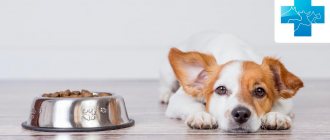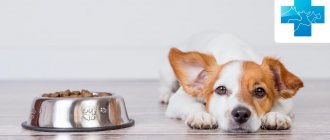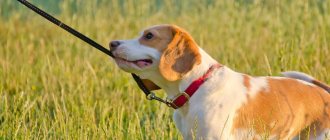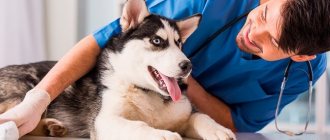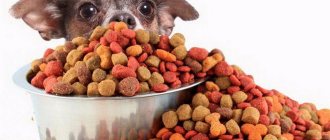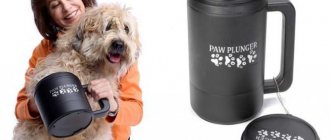A dog is not only man's best friend, but also a constant daily responsibility. It’s not for nothing that they say: “We are responsible for those we have tamed.”
A puppy that appears in the house requires attention and care from the first days, as well as strict education and strict adherence to the regime. In this regard, many owners who have a four-legged friend for the first time have a question: When to feed the dog, before or after walking?
The answer in this case is quite simple. The physiology of a dog is not much different from that of a human; after a hearty meal, he will not want to actively explore the world, so it is best to feed your pet after returning from the street.
Regardless of the breed or activity during the day, physical activity and character, any dog obeys its physiology, which means it will want to eat after it has actively run and relieved itself of all its needs.
When is the best time to walk your dog, before or after meals?
It all depends on what the purpose of your walk is. If you only went out to let your dog go to the toilet, it doesn't matter whether you feed him before or after his meal.
But if this is a long walk, perhaps forced, then it is best if there is a break between the meal and the walk. Now let's look at it in detail.
When should you walk your dog, before or after meals?
Walking to go to the toilet
The breed and age of your pet will matter here. For example, if your dog is still a puppy and you are training it to use the toilet outside, then after waking up, take the animal for a walk and only then feed it breakfast. This will become a daily ritual that will become a habit for you and your pet. If you stick to the same time, then the animal's intestines will work like clockwork, and the dog will be healthy and happy.
When your puppy is very young, he may need to empty his bladder and poop shortly after eating. Be careful and take him out again if necessary to establish a daily routine.
Since puppies drink and eat more often than adult dogs, they also go to the toilet more often.
But as your puppy gets older, you can start taking him outside 5 to 30 minutes after eating. The need for food decreases, and food will take longer to digest. Just like adults, adult dogs can also control their bladders for a few minutes before you take them outside. Therefore, calmly take a break for up to half an hour after eating and only then go for a walk.
Walking for education and training
If you plan to turn a walk into useful entertainment for your dog, into a real active workout, then you should:
- After eating, you need to wait 2 hours and only then go for a walk.
- And after an active walk, you need to wait 30 minutes before feeding.
Remember, taking your dog for active walks when it has a full stomach, or feeding it immediately after returning from a walk, can be extremely dangerous for it.
This can lead to dilation of the stomach and volvulus.
We have an article on the website about volvulus in dogs with our comments, symptoms and stages of development of the pathology. We recommend reading it, if only because it contains many recommendations on choosing a dog breed and what you need to pay attention to. Well, in general, every dog owner should know these signs and symptoms, because it’s dangerous and the hours are ticking. Read the article, at the end we will once again analyze in detail about volvulus in dogs.
Walking for education and training
How to create a daily routine
In most cases, a domestic dog is fed twice a day, in equal portions in the morning and evening. The food used in feeding should not be too varied, but at the same time it must contain everything the dog’s body needs. Since a dog's digestive system selects different enzymes to digest different foods, it is advisable to alternate between them. For example, it is better to give meat rich in animal proteins in the evening, and leave carbohydrate porridge with vegetables for morning meals. This will promote proper digestive processes and eliminate health problems for the dog.
If the owner feeds an adult animal once a day, then to develop cleanliness in him, you can adhere to the following feeding and walking plan:
- walking in the morning - 7:00;
- daytime walking - 14:00;
- feeding with daily allowance of food - 18:00;
- evening walk - 21:30.
At night, all processes inside the dog’s body are inhibited, so a sleepy animal will not ask to go to the toilet until the morning. True, this is only if the pet has already been taken for a walk after the evening meal.
Did you know? The intelligence of many adult dogs is comparable to the abilities of three-year-old human children. Animals are able to recognize up to 300 words, count to 5, and even solve basic math problems.
Feeding after a walk
Therefore, it is safer to take your pet for a walk before eating .
Should you give your dog food immediately upon returning from a walk?
Our experts are against this; if the walk was fast and truly stimulating, the body’s vital signs will be at a high level. Heart rate, blood pressure and the like will be in an exaggerated state, as will your dog, who may be excited about the training.
It also causes dysfunction of the sphincter located between the esophagus and stomach, and can have the same effect as eating immediately after a walk. The risk of getting volvulus (GDV) is also high in this situation.
But don't panic right away. It's best to be aware of this, be careful and allow your pet to relax before and after eating so that the digestive system can do its job calmly.
It would be ideal to provide a pause before feeding the dog after a walk for at least 30 minutes, and preferably 45-60 minutes.
Food digestion process
During feeding, the dog’s body receives all the elements necessary for further life, this happens in several stages . At the first stage, it needs to digest food, break it down into enzymes, and then absorb it in the body.
When the dog has eaten, mechanical processing of food in the mouth cavity begins (this is the second stage). In the third stage, food enters the stomach and is digested. Once the food bolus gets into it, it mixes with gastric juice containing hydrochloric acid and enzymes that break down proteins, fats and other substances into forms that are easily digestible by the body. The food gruel processed in the stomach enters the small intestine and is absorbed by the body.
Number of dog feedings
Puppies can ask for food two to three times a day; an adult dog can easily survive on two feedings a day. Babies may need to go for a walk immediately after eating.
An adult dog may sometimes refuse to eat at all for a day. This is normal as long as the dog is active and healthy. If anything, it will give your digestive system some rest.
However, if the dog has not eaten enough for some time, then walk calmly, walk at a slow pace. Low glucose levels reduce your dog's energy, and long brisk walks can be tiring for him.
Watch your pet eat and follow nature's call. By establishing a daily routine, you help your pet stay healthy.
There should be a gap of 8-12 hours between breakfast and the next meal. You should walk with the animal in the morning and evening 45-60 minutes before meals.
When does the dog go to the toilet?
The digestion process in canines, even at a young age, is quite slow and takes several hours. If you feed your dog well, then she will be able to do her business for the most part in 6-12 hours, depending on the food, provided she has a healthy digestive system.
The pet will also not be eager to go for a small break right away. It takes time for the liquid to go through a full cycle of circulation through the dog’s organs.
Based on these physiological features, a measured schedule for the dog’s life should be built, starting from 4-6 months of age.
By the 10th month, the pet will be almost an adult, all processes in its body will improve, so it will be possible to build the most convenient system. Experienced breeders recommend building a schedule like this:
- Early morning - walk. The dog should get rid of everything that has been digested and accumulated during the night.
- After a morning walk, you can give him something to drink (provided he has access to the street during the day) and something to eat if you prefer two meals a day.
- The middle of the day is a short exit.
- Evening 18.00-19.00 hearty lunch.
- 22.00 evening promenade.
This schedule is ideal for the natural rhythms of the body of a dog of any breed.
Serving Size
You should also consider the size of your food when planning your outing. If your pet has just had a snack, then you should go for a walk after 20-30 minutes.
If the portion size was large, it is recommended to take a longer break, which we wrote about above.
You can take your pet for a walk for 20-30 minutes before eating. However, if the dog is overweight, then the walk should be calm, otherwise the animal may have heart problems. Upon returning from a walk, give the animal water and leave a gap until the next meal.
Typically, dogs are overweight due to food being available at all times and not being active enough to burn it off. It is best to stick to a strict schedule. You may not be able to resist those melting eyes that can make you feel guilty if you don't share tidbits sometimes. Tidbits are fine, but don't overfeed your dog, especially with treats.
What can and cannot be given
Dogs can eat different foods, but this does not mean that you can give your pet anything. It is important to feed your dog properly. There are foods and substances that harm the animal’s body:
- Currants and grapes. Kidneys are affected.
- Mushrooms. Contain toxins that lead to poisoning and death.
- Fats. They become the cause of pancreatitis.
- Potato. It often causes diarrhea.
- Bones of fish, birds and animals. Causes intestinal obstruction and organ ruptures.
- Sweets. Teeth become damaged and body weight increases.
- Citrus. They provoke vomiting.
- Onion garlic. Anemia occurs.
- Raw meat. It may contain E. coli or salmonella.
- Chocolates. Affect the functioning of the heart and central nervous system. Vomiting and diarrhea also appear.
- A raw egg. Leads to salmonellosis, problems with the skin and coat.
- Bouillon. Poorly absorbed, diarrhea occurs.
- Lots of salt. Possible electrolyte imbalance.
- Oatmeal, egg. They are not processed by the body and can cause allergies.
- Peas. It is poorly digested, causing bloating, flatulence, pain and intestinal upset.
- Yeast dough. It ferments and causes gas formation and pain in the digestive system.
You are allowed to give your dog:
Keep in mind! You need to add 10–15 ml of vegetable oil to your dog’s food. It is not forbidden to introduce greens (parsley, leeks, dill).
You can periodically give dry food; it contains all the necessary elements for the normal functioning of organs. It is better to feed your dog good ingredients; cheap ones do not contain the necessary vitamins, micro- and macroelements.
When loved ones give a pet or a person takes one in, he has a lot of questions. These include features of nutrition, care, walking.
A dog has been a faithful friend and helper of man since ancient times. These animals are like children, they also need care, they need affection, love and, of course, a little patience. If a dog feels cared for, then it will always be faithful to its owner.
Quite often, people ask themselves the question of what time is best to feed their dog, before or after a walk, and whether the breed of the animal affects this.
The answer to this question is simple: a dog, like a person, after a hearty lunch only wants to sleep and there is no talk of any walks.
All dogs are divided into three groups:
- Service (military, guard, sled, shepherd);
- Hunting (industrial and sports);
- Indoor decorative.
The physiology of these species is the same and the feeding principle is the same.
Volvulus is a risk for a dog if you walk after eating
Volvulus is a risk for your dog if you walk after eating
Volvulus is a condition common to deep-chested breeds such as Greyhounds, German Shepherds and Labradors, but can also occur in other dogs. So be careful.
Some of the factors that can trigger the disease are anxiety, worry, stress, rigorous training and eating a large diet. Walking with vigorous exercise and then returning to a filling meal is a potentially dangerous combination that can cause volvulus.
If your dog is very hungry after a walk, he will most likely eat the food quickly, which can cause volvulus.
Intestinal volvulus is not just banal gastritis, but something more serious and dangerous, or rather, even deadly for your dog.
Watch for the following signs and symptoms:
- Your dog may be very agitated, tense, or anxious shortly after walking and eating.
- She may have a bloated stomach due to gas buildup in the stomach.
- The dog may struggle to have a bowel movement, sometimes even whining in pain.
- It may be unpleasant and painful for the animal.
- Possible vomiting of white foam or non-productive vomiting (when there is an urge, but nothing comes out)
This is a very painful and not a good situation for your dog.
Therefore, to avoid such a problem, it is necessary to maintain a 2-hour pause after eating, before an active walk with games and training.
Also, veterinarians recommend not feeding dogs large portions. Also, teach your pet to eat slowly. Provide plenty of water and allow your pet to rest after feeding to allow the stomach to slowly digest the food.
Further information from the website of the leading UK clinic thevet.co.uk here is a link to the original volvulus (GDV information in English)
How does volvulus develop: phases of pathology?
| PHASE 1 | The stomach begins to expand and twist | Anxious, restless, pacing, drooling, swollen/painful abdomen | Call your veterinarian for immediate advice. If possible, take your dog to the vet immediately. | The dog can recover from this phase with a slight release of pressure from the veterinarian. |
| PHASE 2 | The blood supply to part of the stomach is cut off, the twisting intensifies, and the dog goes into shock. | Very restless, whines and breathes heavily, drools profusely, stands with his legs apart and his head hanging down, his gums are dark red. | Take your dog to the vet as quickly as possible. | At this point, your veterinarian may need to perform surgery to correct the twists in your dog's abdomen and place your dog on an IV. |
| PHASE 3 | The shock is now very strong, the dog will suffer from further internal problems | The animal is unable to stand, the abdomen is very swollen, shallow breathing, pale gums | Take your dog to the vet as soon as possible. | The veterinarian will attempt to provide life-saving first aid and surgery |


